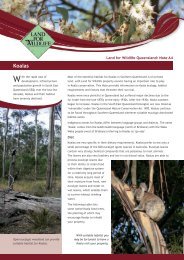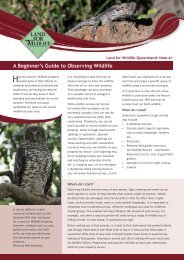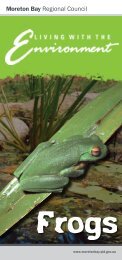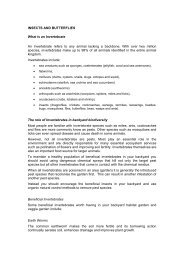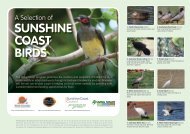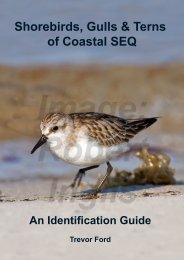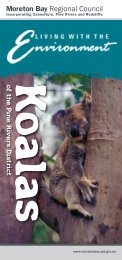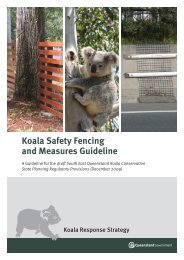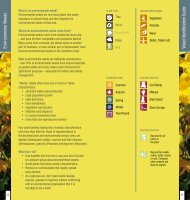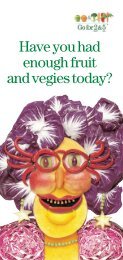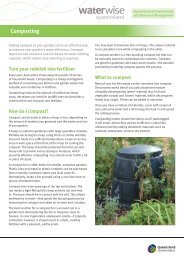Alternatives to Feeding Wildlife - Land for Wildlife South East ...
Alternatives to Feeding Wildlife - Land for Wildlife South East ...
Alternatives to Feeding Wildlife - Land for Wildlife South East ...
Create successful ePaper yourself
Turn your PDF publications into a flip-book with our unique Google optimized e-Paper software.
<strong>Alternatives</strong> <strong>to</strong> <strong>Feeding</strong> <strong>Wildlife</strong><strong>Land</strong> <strong>for</strong> <strong>Wildlife</strong> Queensland: Note A3Everyone loves <strong>to</strong> see wildlifeup close and feeding is oneway of attracting birds and animalsclose enough <strong>to</strong> view them easily.Un<strong>for</strong>tunately, feeding wildlife maybe harmful because it encouragesunnatural animal behaviour, can lead<strong>to</strong> an unbalanced diet and can create adependency on the food being provided.This Note identifies ways thatlandholders can attract wildlife <strong>to</strong> theirproperty with long-lasting benefits <strong>for</strong>both landholder and wildlife. Ratherthan providing food directly, habitat canbe created <strong>for</strong> wildlife by planting foodsupplies and providing shelters that willencourage wildlife <strong>to</strong> keep returning.How can feeding wildlife be harmful?While there is not a significant body of scientific research in<strong>to</strong> the effects offeeding wildlife, there is evidence that direct feeding of wildlife may be harmful.The following issues have been raised regarding the direct feeding of wildlife basedon observation and experience:• Artificial feeding sites can provide food unsuitable <strong>for</strong> wildlife. In particular,foods such as meat and bread are not a natural part of an animal’s diet and cancause problems with the gut. Bread is a particular problem, because it is easilydigestible and can ferment and cause a build up of acid in the gut of animals(referred <strong>to</strong> as lactic acidosis).• Animals that are regularly fed can lose their fear of people, making them morevulnerable <strong>to</strong> malicious acts.• Animals may be more vulnerable <strong>to</strong> attack by domestic animals, either whenthey are feeding or from becoming over-familiar with domesticated animals.• Some wildlife can become aggressive and will demand food or cause a nuisance.Aggressive behaviour has been known <strong>to</strong> result in injuries <strong>to</strong> humans (eg.magpie swooping) and other animals, as well as property damage such chewingof timber and other fixtures by cocka<strong>to</strong>os.Satin Bowerbirds feed mostly onrain<strong>for</strong>est fruits as well as insects,flowers and nectar. Food left aroundpicnic areas, where this female wasobserved, is not part of their naturaldiet. Pho<strong>to</strong> by Deborah Metters.• Diseases can be passed on atfeeding stations when an infectedbird or animal comes in<strong>to</strong> closecontact with healthy animalsby sharing the same food orwater source. Diseases, such asLumpy Jaw in animals, or birdborne diseases, including thehighly contagious psittacosisand psittacine beak and featherdisease, can be spread by contact,feather dander, saliva anddroppings.• Dropped or left over food canattract pest and feral animalslike House Sparrows, Common (orIndian) Mynas, rats and mice.<strong>Feeding</strong> wildlife gives people a personalwildlife experience but may create longterm problems <strong>for</strong> wildlife.
Does feeding wildlife help them?<strong>Wildlife</strong> feeding has limited conservation value as it candisrupt the natural balance of animal populations and availableresources. This can occur in a number of ways.Only a small number of native animals and birds within anecosystem can take advantage of the foods on offer. <strong>Feeding</strong>can artificially boost some animal populations and create animbalance. For example, feeding may attract large numbersof Common Brushtail Possums. This can result in other treedwellingmammals or birds having difficulty as they arecompeting with an abundant and aggressive rival <strong>for</strong> scarceresources such as nest hollows. <strong>Feeding</strong> aggressive wildlife,such as kookaburras or magpies, can also disadvantage othernative species of milder temperament when competing <strong>for</strong>food or other resources.Some people feed wildlife <strong>to</strong> assist survival rates duringdroughts. This interferes with the natural balance in theAustralian bush, when animal numbers ‘boom’ in good timesand die off or ‘bust’ in the bad. Keeping wildlife populationsartificially high in a time when resources are scarce can causelong term damage <strong>to</strong> degraded landscapes and place extremepressure on remaining resources.<strong>Wildlife</strong> can become a problem when there is a regularsource of food provided such as picnic grounds andcoffee shops in bushland areas.A more natural way <strong>to</strong> attract wildlife <strong>to</strong> your property<strong>Feeding</strong> native wildlife is a contentious issue and there are a variety of opinions about the impacts. It may be best <strong>to</strong> take acautious approach and attract wildlife <strong>to</strong> your land in a more natural way. It will also provide habitat <strong>for</strong> many of the animalsyou cannot see and contribute <strong>to</strong> your local biodiversity.Protecting and improving habitat on your land is the best way <strong>to</strong> enjoy wildlife up close. Creating habitat will provide food,shelter and places <strong>to</strong> breed <strong>for</strong> a range of animals. You can protect and improve habitat by:• Keeping existing natural vegetation on your property.• Creating diverse native habitats on your property. This includes unders<strong>to</strong>rey, mids<strong>to</strong>rey and canopy plants, along with fallenlogs and leaf litter. Don’t be tempted <strong>to</strong> ‘tidy-up’ the bush.• Finding out about the natural diet of the wildlife you want <strong>to</strong> attract and provide suitable habitat and food plants.Different species of wildlife require different types of food and shelter. Plant native grasses and herbs <strong>for</strong> seed-eating,ground-feeding birds like finches. Fruiting native shrubs and trees will provide food <strong>for</strong> fruit-eating, tree-feeding birds likeparrots and cocka<strong>to</strong>os. Carnivorous birds such as kookaburras, magpies and butcherbirds require healthy leaf litter andstructural vegetation (i.e. trees and shrubs <strong>for</strong> perching) <strong>to</strong> catch invertebrates, small reptiles and mice. Insectivorous and/or nectar-feeding birds, such as honeyeaters, fly-catchers and robins need structural vegetation and healthy leaf litter <strong>to</strong>catch flying insects, ground-dwelling invertebrates like spiders, as well as nectar-providing plants.• Planting a variety of native trees and shrubs that flower or fruit at different times of the year.
• Remembering <strong>to</strong> also provide habitat <strong>for</strong> insects, otherinvertebrates, skinks and frogs.• Improving dams <strong>to</strong> create wildlife-friendly environments, witha shallow, reedy area as well as a deep area <strong>to</strong> encourage amix of wading and diving birds. (See <strong>Land</strong> <strong>for</strong> <strong>Wildlife</strong> Note W3- Dam <strong>Wildlife</strong>).• Providing nesting sites (including nest boxes) and otherwildlife shelters which will be of assistance <strong>to</strong> some wildlifespecies.Natural habitats can be enhanced even in the most heavilypopulated parts of Queensland, like the greater Brisbane area.Implementing some of the points suggested above can help <strong>to</strong>provide suitable habitat <strong>for</strong> a range of wildlife species.Mistle<strong>to</strong>e is an important food resource<strong>for</strong> butterflies, birds and some mammalssuch as possums.If you decide <strong>to</strong> directly feedwildlife, you can still reduce yourimpactNest boxes can be used <strong>to</strong> supplement a lack of hollow trees byproviding roosting and nesting sites <strong>for</strong> a diversity of wildlife species.Grey-crowned Babblers are energetic birds that <strong>for</strong>age from theground <strong>to</strong> high limbs of trees.There are some important things you cando if you want <strong>to</strong> avoid the more harmfulaspects of wildlife feeding. These include:• Placing the food station in the open, sothat wildlife can spot preda<strong>to</strong>rs.• Avoid using a feeder and changefeeding locations regularly <strong>to</strong> preventcontamination and reduce the risk ofdisease.• Never provide processed foods of any kind.• Use proper wild bird mixture and avoidblack sunflower seeds as they are <strong>to</strong>o richin oil.• Limit the amount of food that you put out.• Put food out at irregular intervals and atdifferent times.• Make sure water is provided in a safe spo<strong>to</strong>ut of reach of preda<strong>to</strong>rs and that thewater is changed regularly.• Do not handle wildlife.• Never feed wildlife in a national park orconservation reserve. These areas arespecifically set aside <strong>to</strong> allow naturalinteractions between species.• Keep your pets away from feeding areas.Note A3: <strong>Alternatives</strong> <strong>to</strong> <strong>Feeding</strong> <strong>Wildlife</strong>
Where <strong>to</strong> find out moreThe Birds Australia website provides adviceon how <strong>to</strong> create a refuge <strong>for</strong> birds basedon research results. See Guidelines <strong>for</strong>the Development of Bird Habitat at www.birdsinbackyards.net/spaces/guidelines.cfmThere are many examples on the internet ofhow <strong>to</strong> establish a wildlife friendly garden.The Society <strong>for</strong> Growing Australian Plantsprovides excellent in<strong>for</strong>mation <strong>for</strong> gardeningin a sub-tropical climate at www.sgapqld.org.au/article48.htmlWhat you can do Learn what wildlife frequents your area. Seek <strong>to</strong> maintain or create an environmentthat will provide natural food <strong>for</strong> wildlife. Provide habitat elements <strong>for</strong> a range ofwildlife including fruiting and floweringplants, fallen branches and logs, leaf litterand nesting sites. Include native grasses and sedges inplantings. Remember <strong>to</strong> provide habitat <strong>for</strong> smallercreatures such as frogs, lizards andinsects. Install nest boxes <strong>for</strong> birds, possums,gliders and insectivorous bats. Provide safe water points <strong>for</strong> wildlife. If you choose <strong>to</strong> feed wildlife, provide‘natural’ foods on an irregular basis andensure that food and water stations arekept clean <strong>to</strong> reduce the risk of disease. Do not feed wildlife in national parks orreserves.Native grasses such as Kangaroo Grass are a natural food source<strong>for</strong> a range of wildlife such as kangaroos and wallabies.Different habitat attracts a diverse range of species by providingthem with opportunities <strong>to</strong> feed, breed and shelter. Waterwaysallow frogs and other aquatic animals <strong>to</strong> breed. This frog spawn(circled) was observed after rain.<strong>Land</strong> <strong>for</strong> <strong>Wildlife</strong> Notes are distributed free of charge <strong>to</strong> members of the <strong>Land</strong> <strong>for</strong> <strong>Wildlife</strong> program in Queensland. <strong>Land</strong> <strong>for</strong> <strong>Wildlife</strong> is avoluntary program that encourages and assists landholders <strong>to</strong> provide habitat <strong>for</strong> wildlife on their properties.For more in<strong>for</strong>mation on <strong>Land</strong> <strong>for</strong> <strong>Wildlife</strong> visit: www.seqcatchments.com.au/LFW.htmlProduction of <strong>Land</strong> <strong>for</strong> <strong>Wildlife</strong> Notes was generously funded by the following agencies:In<strong>for</strong>mation published in <strong>Land</strong> <strong>for</strong> <strong>Wildlife</strong> Notes is not necessarily endorsed by any of the supporting agencies, nor should it be taken <strong>to</strong>constitute professional advice or a <strong>for</strong>mal recommendation of land management.



